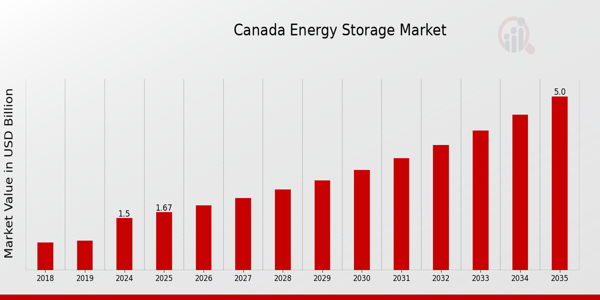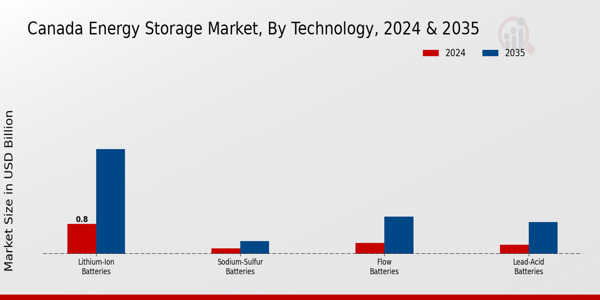Canada Energy Storage Lithium Battery Market in 2025
Canada’s energy storage market is experiencing a surge in 2025, with lithium-ion batteries, including the increasingly popular LiFePO4 (lithium iron phosphate) variant, at the heart of this transformation. As the country pushes toward a low-carbon future, energy storage is becoming essential for managing renewable energy sources like solar and wind, ensuring grid stability, and powering everything from homes to businesses to off-grid adventures. In this article, we’ll explore the state of Canada’s energy storage lithium battery market in 2025, focusing on three key segments: residential, commercial & industrial (C&I), and outdoor applications (RV and marine). We’ll also highlight key manufacturers, market drivers, challenges, and what’s fueling this exciting growth.
Market Overview
The Canadian energy storage market is estimated to reach approximately US$1.674 billion in 2025, driven by the increasing adoption of renewable energy, supportive government policies, and advancements in battery technology. Lithium-ion batteries dominate due to their high energy density, efficiency, and declining costs, with LiFePO4 batteries gaining traction for their safety and longevity. The market can be segmented by application into:
- Residential: Home energy storage systems, often paired with solar panels.
- Commercial & Industrial (C&I): Systems for businesses and industries to manage energy costs and reliability.
- Utility-Scale: Large-scale projects for grid support (not the focus here but significant in the overall market).
- Outdoor Applications (RV, Marine): Niche but growing use in recreational vehicles and boats.
Below, we dive into each segment, providing insights into their size, trends, and key players.

Residential Energy Storage
Market Size and Growth
In 2025, the residential lithium-ion battery energy storage market in Canada is projected to be worth around US$169.6 million, based on estimates derived from a compound annual growth rate (CAGR) of 35.7% from 2024 to 2030. Starting from US$92.2 million in 2023, the market is expected to grow rapidly as more homeowners adopt solar photovoltaic (PV) systems and seek reliable backup power solutions.
Why It’s Growing
The residential segment is booming for several reasons:
- Solar PV Adoption: More Canadians are installing solar panels, and batteries are essential for storing excess energy generated during the day for use at night or during cloudy periods.
- Rising Electricity Costs: Storing energy during off-peak hours and using it during peak times helps homeowners save on utility bills.
- Power Outages: With extreme weather events on the rise, batteries provide critical backup power, ensuring homes stay powered during outages.
- Government Incentives: Policies like the Clean Technology Investment Tax Credit encourage investment in energy storage systems.
Key Technologies
Lithium-ion batteries, particularly LiFePO4, are the go-to choice for residential applications. LiFePO4 batteries are favored for their safety (lower risk of thermal runaway), long cycle life (up to 15,000 cycles), and environmental friendliness compared to other lithium-ion chemistries like nickel manganese cobalt (NMC). These batteries typically range from 3 kW to 5 kW in power rating, with the 3 kW to 5 kW segment holding a 68.55% revenue share in 2023, while smaller systems (less than 3 kW) are the fastest-growing.
Key Manufacturers
Several companies are leading the residential energy storage market in Canada:
- Tesla: Known for its Powerwall, a sleek, high-capacity battery for home use.
- LG Chem: Supplies efficient lithium-ion batteries with advanced battery management systems (BMS).
- Panasonic: Offers reliable solutions for residential solar integration.
- Electrovaya: A Canadian company specializing in lithium-ion battery systems for various applications.
- NRStor: Another Canadian player, focusing on innovative storage solutions for grid and residential use.
Trends to Watch
- Smart Energy Management: Integration with smart home systems allows homeowners to monitor and optimize energy use via apps.
- Net-Metering Policies: These enable homeowners to sell excess energy back to the grid, boosting the appeal of storage systems.
- Cost Reductions: A 15% cost reduction in energy storage systems from 2019 to 2022, as reported by the National Research Council, is making batteries more affordable.
Commercial & Industrial (C&I) Energy Storage
Market Size and Growth
The C&I energy storage market in Canada is estimated at approximately US$418.5 million in 2025, accounting for about 25% of the total energy storage market. This estimate is based on the overall market size of US$1.674 billion and typical segment shares, as specific data for Canada’s C&I segment is limited. Globally, the C&I battery energy storage systems (BESS) market is projected to grow from US$3.18 billion in 2023 to US$10.88 billion by 2030, with a CAGR of 20.1%, suggesting strong growth potential in Canada as well.
Why It’s Growing
The C&I segment is critical for businesses and industries looking to optimize energy use and enhance reliability:
- Peak Demand Management: Batteries help businesses avoid high demand charges by storing energy during low-cost periods and using it during peak times.
- Renewable Integration: Companies adopting solar or wind power rely on storage to manage intermittent energy production.
- Energy Resilience: Data centers, hospitals, and manufacturing facilities need uninterrupted power, making batteries essential.
- Sustainability Goals: Businesses are under pressure to reduce carbon emissions, and energy storage supports this by enabling renewable energy use.
Key Technologies
Lithium-ion batteries, including LiFePO4 and NMC chemistries, dominate the C&I segment due to their scalability and efficiency. LiFePO4 batteries are particularly valued for their safety and long lifespan, making them suitable for demanding industrial applications. Medium-scale systems are common in commercial settings, balancing cost and performance, while large-scale systems support grid stability and renewable projects.
Key Manufacturers
Leading players in the C&I segment include:
- Tesla: Its Megapack is widely used for large-scale commercial projects.
- Fluence: A joint venture between Siemens and AES, offering advanced storage solutions.
- Siemens: Provides integrated systems for industrial energy management.
- Hydrostor: A Canadian company specializing in compressed air energy storage, complementing lithium-ion solutions.
- e-Zinc: A Canadian innovator developing zinc-based batteries for long-duration storage.
Trends to Watch
- Solar-Plus-Storage: Many businesses are pairing batteries with rooftop solar to maximize energy autonomy.
- Energy Management Systems: Advanced software optimizes battery charging and discharging, improving efficiency.
- Government Support: Investments like the US$1.5 billion in clean technology funding in 2021 are boosting C&I projects.
Outdoor Applications (RV, Marine)
Market Size and Growth
Specific data for the outdoor (RV and marine) segment in Canada for 2025 is scarce, as it’s often included within the residential or C&I markets. However, based on the growing popularity of lithium-ion batteries in these applications, we can estimate it as a niche segment, potentially worth around US$50 million in 2025, though this is a rough approximation. The demand for lightweight, durable batteries in RVs and marine vessels is rising as Canadians embrace off-grid lifestyles and sustainable boating.
Why It’s Growing
- RV Lifestyle: The popularity of RV camping is driving demand for reliable, lightweight power sources for off-grid adventures.
- Marine Applications: Boats and yachts are increasingly using lithium batteries for auxiliary power, navigation, and electric propulsion.
- LiFePO4 Advantage: These batteries are lighter and last longer than traditional lead-acid batteries, making them ideal for mobile applications.
Key Technologies
LiFePO4 batteries are the preferred choice for RV and marine applications due to their safety, high cycle life, and ability to operate in extreme conditions (e.g., cold Canadian winters). Features like built-in battery management systems (BMS) with Bluetooth connectivity and low-temperature protection enhance their appeal.
Key Manufacturers
- LiTime: Offers LiFePO4 batteries with advanced features like self-heating for cold climates.
- Battle Born Batteries: Known for durable, high-performance batteries for RVs and boats.
- Renogy: Provides integrated solar and battery solutions for off-grid applications.
- Volthium: A Canadian company specializing in lithium batteries for RV, marine, and solar use.
Trends to Watch
- Cold-Weather Performance: Batteries designed for Canada’s harsh climate are in high demand.
- Portable Solutions: Compact, modular batteries are making it easier for RV and marine users to upgrade.
- Sustainability: Eco-conscious adventurers are choosing lithium batteries for their lower environmental impact.

Market Drivers
Several factors are propelling the growth of Canada’s energy storage lithium battery market:
- Government Incentives: The Canadian government’s Clean Technology Investment Tax Credits and funding programs, such as the US$500 million Smart Renewables and Electrification Pathways program, support energy storage projects.
- Renewable Energy Integration: With solar and wind power becoming more prevalent, storage is critical for managing intermittent energy production.
- Grid Stability: Battery energy storage systems (BESS) provide frequency regulation and voltage support, ensuring a reliable grid.
- Technological Advancements: A 15% cost reduction in energy storage systems from 2019 to 2022, along with improvements in battery chemistry and energy density, is making lithium-ion batteries more accessible.
Challenges
Despite the promising growth, the market faces several challenges:
- High Initial Costs: The upfront cost of lithium-ion battery systems can be a barrier, especially for smaller businesses and homeowners.
- Regulatory Variations: Canada’s decentralized governance means regulations differ by province, complicating project development.
- Supply Chain Risks: Dependence on global supplies of lithium, cobalt, and other materials can lead to price volatility and disruptions.
Key Manufacturers in Canada’s Market
Canada is home to several innovative companies contributing to the energy storage market, alongside global giants:
- Electrovaya: Based in Ontario, it develops lithium-ion battery systems for various applications.
- NRStor: Focuses on energy storage projects, including partnerships with HydroQuébec.
- Hydrostor: Specializes in advanced compressed air energy storage but also supports battery projects.
- e-Zinc: Innovates with zinc-based batteries for long-duration storage.
- Volthium: A Canadian manufacturer of LiFePO4 batteries for RV, marine, and solar applications.
Global players like Tesla, LG Chem, Panasonic, Fluence, and Siemens also have a strong presence, supplying advanced lithium-ion solutions tailored to Canadian needs.
Market Size Estimates for 2025
The following table summarizes the estimated market sizes for the key segments in 2025:
| Segment | Estimated Market Size (2025) | CAGR | Key Drivers |
|---|---|---|---|
| Residential | US$169.6 million | 35.7% (2024-2030) | Solar adoption, cost savings, backup power |
| Commercial & Industrial | US$418.5 million | ~20% (global estimate) | Peak demand management, renewable integration |
| Outdoor (RV, Marine) | ~US$50 million (estimated) | N/A | Lightweight batteries, off-grid demand |
Note: The outdoor segment estimate is approximate due to limited specific data.
Future Outlook
Looking ahead, Canada’s energy storage market is poised for continued growth. The Canadian Energy Regulator projects that installed energy storage capacity (>1 MW) could increase from 552 MW in 2024 to 1,149 MW by 2030, with potential to reach 2,768 MW if all proposed projects are built. Lithium-ion batteries will remain dominant, with LiFePO4 playing a growing role due to its safety and durability. Ontario and Alberta are leading the charge, with projects like the Oneida Battery Energy Storage System (250 MW, to be commissioned in 2025) showcasing the country’s commitment to energy storage.
As Canada aims for net-zero emissions by 2050, energy storage will be a cornerstone of this transition, supporting renewable energy integration and grid reliability. With ongoing investments, technological advancements, and supportive policies, the lithium battery market is set to power Canada’s clean energy future.
Conclusion
In 2025, Canada’s energy storage lithium battery market is thriving, with residential, commercial & industrial, and outdoor applications driving significant growth. Lithium-ion batteries, particularly LiFePO4, are at the forefront, offering efficient, reliable, and sustainable solutions. Whether you’re a homeowner looking to save on energy bills, a business aiming to optimize operations, or an adventurer needing power for your RV or boat, there’s a lithium battery solution for you. Despite challenges like high costs and supply chain risks, the market’s future is bright, supported by innovation and government backing. Canada is well-positioned to lead in energy storage, paving the way for a cleaner, more resilient energy landscape.
